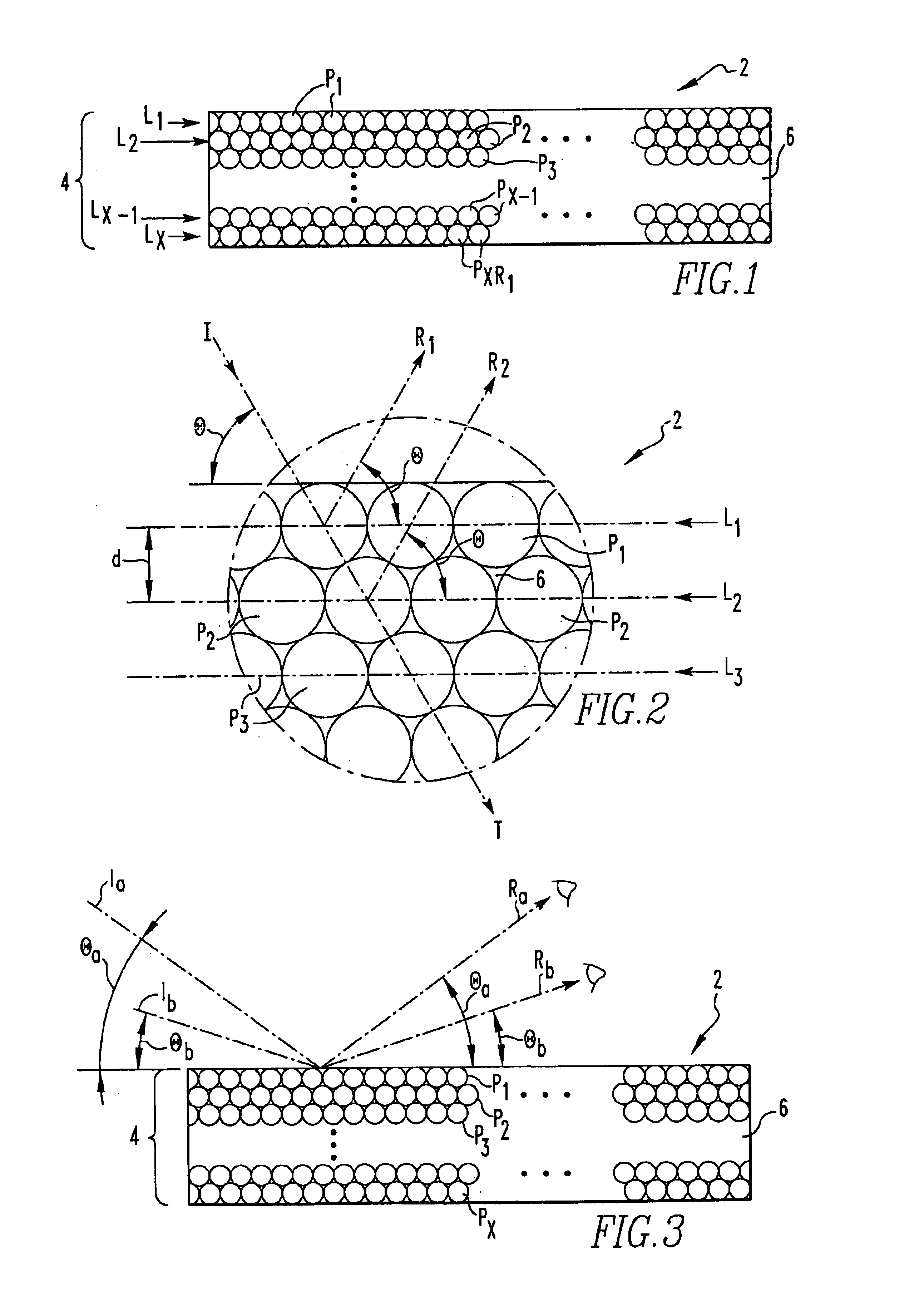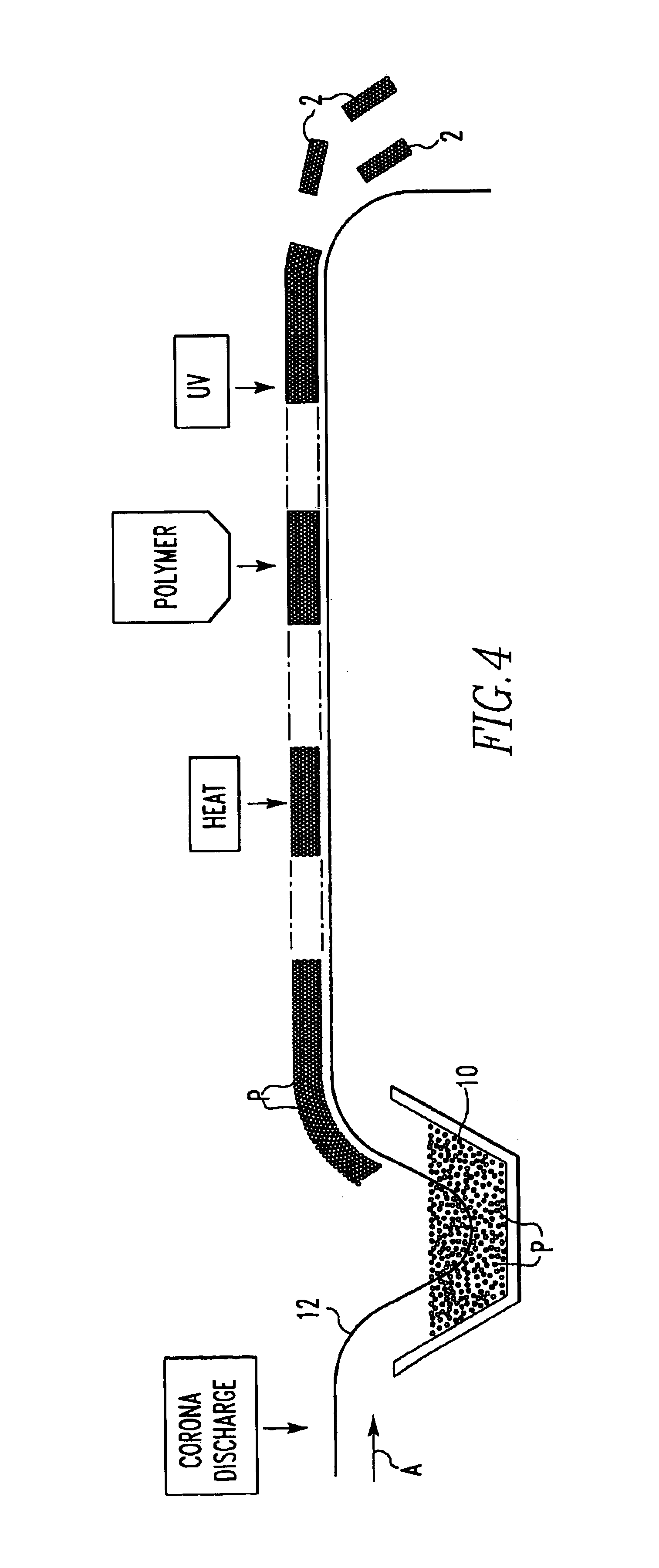Color effect compositions
a technology of compositions and pigments, applied in the field of color effect pigments, can solve the problems of color effect, liquid crystals are not as physically durable, and the color effect is not uniform
- Summary
- Abstract
- Description
- Claims
- Application Information
AI Technical Summary
Benefits of technology
Problems solved by technology
Method used
Image
Examples
example 1
Organic Polymer Matrix
[0051]An ultraviolet radiation curable organic composition was prepared via the following procedure. Diphenyl(2,4,6-trimethylbenzoyl)phosphine oxide / 2-hydroxy-2-methylpropiophenone (40 grams), 50 / 50 blend from Aldrich Chemical Company, Inc., Milwaukee, Wis., in 116 g of ethyl alcohol and 250 g of ethoxylated(4) pentaerythritol tetraacrylate, from Sartomer Company, Inc., Exton, Pa., were added with stirring to 750 g neopentyl glycol diacrylate from Sartomer Company, Inc., Exton, Pa.
example 2
Organic Particles
[0052]A dispersion of polystyrene-divinylbenzene particles in water, were prepared via the following procedure. One gram of sodium bicarbonate from Aldrich Chemical Company, Inc., was mixed with 853 g of deionized water and added to a reaction kettle, Model# 6947-2I from Corning, Inc., Corning N.Y., equipped with a thermocouple, baffles, stirrer, reflux condenser, heating mantle, and nitrogen inlet. The mixture was sparged with nitrogen for 40 minutes with stirring and blanketed with nitrogen. Aerosol MA80-I (8.2 g) from Cytec Industries, Inc., in 90 g deionized water was added to the mixture with stirring, and the mixture was heated to 50° C. using an electric mantle. Styrene monomer (360 g) from Aldrich Chemical Company, Inc., was added with stirring. 3-Allyloxy-2-hydroxy-1-propanesulfonic acid, sodium salt (17.2 g, 40% in water) from Aldrich Chemical Company, Inc., and 5 g of deionized water were added to the mixture with stirring. The mixture was heated to 60° C...
example 3
[0053]A dispersion of approximately 150 nm diameter silica particles in water was prepared via the following procedure. Ammonium hydroxide (12 g, 28% ammonia in water) from Aldrich Chemical Company, Inc., 40 g of deionized water, and 320 g reagent grade ethyl alcohol from Aldrich Chemical Company, Inc., were added to a 16 fluid ounce glass jar and the mixture was shaken for 30 seconds. Tetraethyl orthosilicate (80 g, 98% purity) and 320 g reagent grade ethyl alcohol, both from Aldrich Chemical Company, Inc., were added to a second 16 fluid ounce glass jar and the mixture was shaken for 30 seconds. The two mixtures were poured into a 32 fluid ounce glass jar and mixed by shaking for 60 seconds then maintained at room temperature for 3 hours. The resulting dispersion was pipetted in 100 ml aliquots into 25 mm flat width, 20 micron wall thickness, 12,000 to 14,000 molecular weight cut off regenerated cellulose dialysis tubing from Fisher Scientific, Pittsburgh, Pa., ...
PUM
| Property | Measurement | Unit |
|---|---|---|
| refractive index | aaaaa | aaaaa |
| refractive index | aaaaa | aaaaa |
| thick | aaaaa | aaaaa |
Abstract
Description
Claims
Application Information
 Login to View More
Login to View More - R&D
- Intellectual Property
- Life Sciences
- Materials
- Tech Scout
- Unparalleled Data Quality
- Higher Quality Content
- 60% Fewer Hallucinations
Browse by: Latest US Patents, China's latest patents, Technical Efficacy Thesaurus, Application Domain, Technology Topic, Popular Technical Reports.
© 2025 PatSnap. All rights reserved.Legal|Privacy policy|Modern Slavery Act Transparency Statement|Sitemap|About US| Contact US: help@patsnap.com


